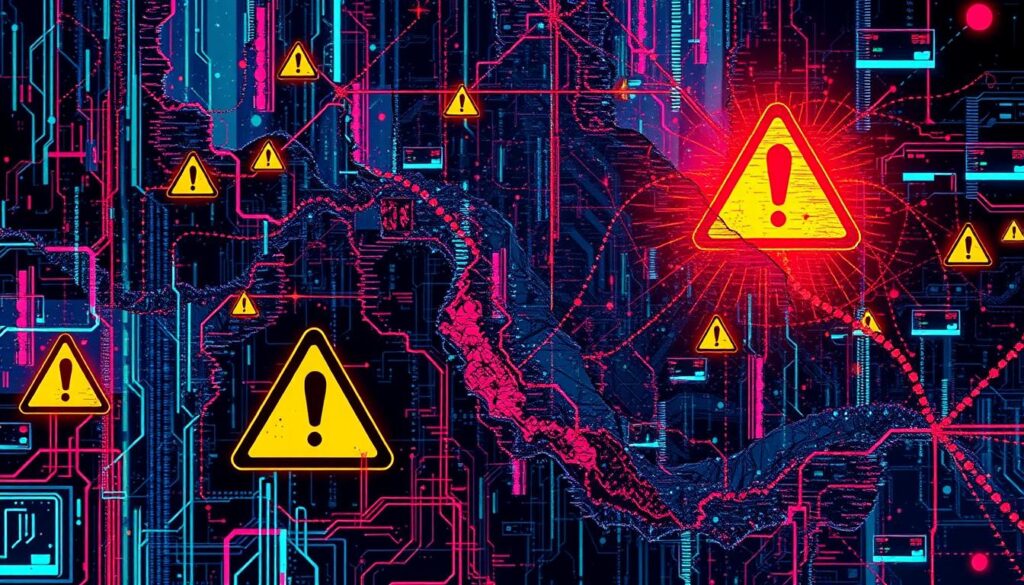Artificial intelligence is being used more and more in different areas. This shows a big problem: AI Is A Digital Disaster that is dangerous for society. As we rely more on these technologies, the problems caused by AI failures are clear.
These issues range from ethical problems to risks to our safety and economy. AI failures can harm our data and even put people’s lives at risk. They can also hurt the economy in many fields.

We need to pay close attention to how AI dangers can affect us. It’s important to understand these risks to avoid big problems in the future.
Key Takeaways
- AI failures can have profound repercussions on various industries.
- The dependency on AI raises urgent ethical questions.
- Cybersecurity and privacy concerns are heightened with AI integration.
- Real-world impacts demand a serious examination of technology impact on society.
- Mitigating AI risks is essential for future advancements.
The Rise of Artificial Intelligence in Society
The rise of AI has changed many parts of our lives. It has made how we use technology different. This change is thanks to big technological advancements in areas like healthcare, transportation, finance, and communication.
In healthcare, AI helps doctors make better diagnoses and tailor treatments. In transportation, self-driving cars are changing how we move around. The finance world uses AI to spot risks and catch fraud. And in communication, AI makes talking to machines better and sharing info easier.

But, this big change also makes us worry. As AI gets more common, we start to wonder if we’re ready for it. The story of AI Is A Digital Disaster shows we need to be careful with how we use AI.
| Sector | AI Application | Benefits |
|---|---|---|
| Healthcare | Diagnostic tools | Improved accuracy in diagnosis |
| Transportation | Autonomous vehicles | Enhanced safety and efficiency |
| Finance | Risk assessment | Better fraud detection |
| Communication | Chatbots and virtual assistants | Improved customer service |
The rise of AI makes us think about its impact on society. Using these technologies without knowing the risks could lead to big problems. It could challenge our values and how we work.
Understanding the Dangers of AI Technology
The growth of AI technology brings big risks that need careful thought. As companies use AI, they face problems like system failures and misuse. It’s key to know these artificial intelligence dangers to use AI safely.
Automation bias is a big worry. AI results can be trusted too much, leading to bad decisions. This shows why we must be aware of AI technology risks and keep human control in AI work.
Data breaches are a big threat with AI. AI handles a lot of sensitive data, making it a target for hackers. If AI systems aren’t secure, they can harm a company’s money and reputation. Ignoring these risks can hurt data security and privacy.
Lastly, AI’s lack of accountability is a big ethical issue. AI can make choices without human help, making it hard to blame anyone for mistakes. It’s crucial to tackle these ethical problems to make sure AI helps people, not harms them.
| Dangers of AI Technology | Risks | Implications |
|---|---|---|
| Automation Bias | Reduced critical thinking and over-reliance on AI | Poor decision-making consequences |
| Data Breaches | Increased vulnerability to cyberattacks | Financial and reputational damage |
| Loss of Accountability | Ambiguity in responsibility | Ethical dilemmas in AI deployment |

AI Is A Digital Disaster: Why Failures Matter
AI is now a big part of many industries. But, the impacts of AI failures show a scary side of this tech. It’s key for those involved to understand these failures to avoid risks and make AI more reliable. These failures can cause big financial losses, harm a company’s reputation, and make people lose trust in AI.
The Impact of AI Failures on Industries
AI failures hit different sectors in different ways. In healthcare, for example, AI tools might not read data right, leading to wrong diagnoses. This can lead to bad treatments or missing important health issues. The AI negative effects can hurt not just one person but the whole healthcare system as trust drops.
Real-World Examples of AI Disaster Cases
There have been many AI failure cases that show the risks. In 2018, a healthcare AI suggested wrong treatments because of biased data. This not only risked lives but also made people question AI’s ethics. These examples show AI is not just a tool but can be a disaster if not used carefully.
| Industry | Type of AI Failure | Consequences |
|---|---|---|
| Healthcare | Diagnostic Misinterpretation | Increased patient risk, loss of trust |
| Finance | Fraud Detection Failures | Financial losses, legal issues |
| Transportation | Autonomous Vehicle Accidents | Injury, property damage |

Exploring Machine Learning Risks
Artificial intelligence is growing fast, and we need to look at the risks it brings. Knowing these risks helps us make AI systems fair and safe. This includes dealing with bias in AI and unexpected outcomes.
Bias in Machine Learning Algorithms
Bias in AI happens when algorithms make unfair choices because of bad data. Old data often shows unfairness, leading to biased decisions. For instance, hiring tools might pick candidates based on gender or race, causing more harm.
This unfairness can hurt certain groups a lot. It makes society less fair for everyone.
Unintended Consequences of AI Decisions
AI systems are like black boxes, making it hard to see how they decide things. This lack of clearness can lead to bad outcomes. In important areas like healthcare or justice, AI’s choices can have big consequences.
Decisions based on wrong assumptions can cause big problems. We need to understand how AI makes decisions better.

| Type of Risk | Description | Example |
|---|---|---|
| Algorithmic Bias | Discrimination in AI decisions due to biased data | Hiring algorithms favoring certain demographics |
| Lack of Transparency | AI systems operate without clear rationale for decisions | Healthcare algorithms suggesting treatment options based on skewed data |
| Unintended Consequences | Unforeseen negative outcomes from AI decisions | Predictive policing algorithms leading to over-policing of specific neighborhoods |
Technological Impact on Society
Technology, especially artificial intelligence, is changing jobs fast. Old jobs are disappearing as machines make things more efficient. This change brings both good and bad sides, making work and skills needed for jobs different.
Changing Employment Landscapes
New jobs are emerging because of AI. Industries are changing a lot, needing people with skills for AI. Workers need to keep up or they might get left out. This big change means the future of work will include more machines and software.
The Human Cost of AI Integration
Switching to AI in work has a big impact on people. They face mental health issues, job loss, and the need to learn new things. The economy also suffers, making it hard for people to find jobs that need tech skills. We need to work on fair policies and training to help people adjust to AI.

AI’s Ethical Implications
The use of artificial intelligence raises big questions about ethics. Those who create AI must act with moral responsibility. They need to make sure their systems are fair and clear.
As AI spreads into many areas, we need strong rules. Finding a way to balance new ideas with ethics is hard. It’s a big challenge for those in charge.
Moral Responsibility in AI Design
AI can change lives, so its makers must think about the impact. The complex algorithms in AI can lead to surprises. To build trust, developers should focus on making systems that respect our values.
Governance and Regulation Challenges
AI is changing fast, but rules can’t keep up. Current laws don’t fully cover AI’s unique issues. We need help from tech, law, and ethics experts to make good rules.
This team effort aims to support innovation and keep ethics in check. It’s about making sure AI is used for good.

| Challenge | Description | Potential Solutions |
|---|---|---|
| Moral Responsibility | Developers must ensure AI systems promote fairness and transparency. | Establish ethical guidelines and user-centric design principles. |
| Regulation | Existing laws may not adequately govern AI technologies. | Create adaptable governance frameworks and engage in multi-stakeholder dialogues. |
| Collaboration | Effective oversight requires input from various disciplines. | Foster partnerships among technologists, legal experts, and ethicists. |
AI Cybersecurity Threats
Artificial intelligence has changed many industries. But, it also brings big challenges, especially in AI cybersecurity threats. Companies need to know the weaknesses in AI systems that hackers can use. By understanding these and taking action, they can fight off AI cyber threats.
Vulnerabilities Introduced by AI Systems
AI can create new weaknesses that old security methods miss. Some common issues include:
- Data Poisoning: Hackers change the training data to make AI models wrong.
- Model Inversion: Bad guys can get secret training data with smart questions.
- Adversarial Attacks: Small changes in input can trick AI, leading to bad results.
These problems need new, strong security steps. This shows why special AI risk checks are key.
Coping with AI-Driven Cyber Attacks
There are ways to fight AI attacks and keep systems safe. Good steps include:
- Do regular security checks to find AI system weaknesses.
- Use strong monitoring to spot and stop cyber threats.
- Teach staff about AI risks and how to stay safe online.
- Make plans for when AI attacks happen.
By following these steps, companies can better protect against AI threats. This helps keep important data safe.
Digital Transformation Challenges
Bringing artificial intelligence into companies comes with many challenges. To overcome these, it’s important to focus on both people and processes. It’s crucial to understand how AI will change the way things work.
Navigating Change Management with AI
Using AI means you need a strong plan for change. Companies must make sure their workers are ready for new ways of working. Training on AI can help staff get used to new tools and encourage innovation.
Important things to think about include:
- Communication: Keeping everyone updated helps reduce worries.
- Stakeholder Engagement: Getting different teams involved early can help everyone support the change.
- Feedback Mechanisms: Having ways for employees to share their thoughts helps make changes faster.
Adapting to AI in Business Strategies
Switching to AI strategies means looking at old ways of doing things differently. Companies need to make sure their goals match what AI can do. They also need to be aware of the risks.
Things that help with this change include:
- Strategic Planning: Making sure AI plans fit with long-term goals is key to success.
- Data-Driven Decision Making: Using AI to analyze data helps make better decisions.
- Continuous Improvement: Checking how AI is working helps keep things running smoothly.
Mitigating the Negative Effects of AI
To tackle AI’s downsides, we need a clear plan. Companies and people must work together to lessen AI risks. This starts with making AI ethically, being open, and being accountable at every step.
Best Practices for Responsible AI Use
Here are key steps for using AI wisely:
- Ethical Guidelines: Set clear rules for AI creation and use, focusing on fairness and responsibility.
- Transparent Algorithms: Make sure AI’s inner workings are clear to users, building trust.
- Continuous Monitoring: Check AI for bias and effectiveness often, making it better and fairer.
- Stakeholder Engagement: Get many viewpoints in AI design, making it more relevant to society.
Training and Awareness Programs for Users
Teaching users about AI is crucial. Training helps them use AI wisely. Key parts of these programs are:
- Comprehensive Workshops: Teach AI basics, focusing on ethics and risks.
- Simulations and Case Studies: Use real examples to show AI’s impact, stressing the need for careful use.
- Feedback Mechanisms: Let users share thoughts on AI, making them feel involved and responsible.
- Resource Availability: Give users tools and info to make smart choices with AI.
By following these steps, we can improve how people understand and use AI. This way, we can make AI better and safer for everyone.
| Best Practices | Training Programs |
|---|---|
| Ethical Guidelines | Comprehensive Workshops |
| Transparent Algorithms | Simulations and Case Studies |
| Continuous Monitoring | Feedback Mechanisms |
| Stakeholder Engagement | Resource Availability |
AI and Privacy Concerns
The mix of AI and privacy is a big challenge that needs quick action. Companies use AI for many things, but this means they handle a lot of personal data. It’s important to protect this data well to keep privacy safe while using AI.
Data Protection and AI Ethics
Keeping data safe with AI is key because a lot of personal info is collected. When companies don’t protect this data well, it raises big ethical questions. It’s important for data protection rules to match how AI is used to avoid misuse.
Companies should follow rules that make them accountable and open. This way, they can handle user data ethically.
The Role of User Consent in AI Deployments
User consent is very important for building trust between people and companies. When companies are clear about how they use data, people can make better choices. Without clear consent, AI projects can’t be seen as ethical.
By respecting user consent, companies can make people more confident in their AI work.
The Importance of Transparency in AI
Transparency in AI is key for its success in many fields. It lets people understand how AI makes decisions. This builds trust among users and the public.
Companies that focus on ethical AI can be checked by others. This openness helps find and fix any problems. It makes AI more reliable and trustworthy.
Being open also helps with laws and rules. Companies that show how their AI works can follow government standards better. This way, they avoid criticism when things go wrong.
- Open algorithms promote trust and reliability.
- Clear accountability fosters ethical AI practices.
- Transparency aids regulatory compliance and risk management.
Creating a transparent AI culture helps companies look good. It also helps the whole AI world grow. This way, everyone benefits from AI’s progress.
Conclusion
The impact of AI failures is huge. As AI gets smarter fast, we must see the dangers of unexpected mistakes. These can harm many areas, from keeping data safe to making tough choices.
Creating AI responsibly is key to avoiding harm. Everyone involved must work together. This means focusing on what’s right and fair in AI.
The future of AI looks promising, but we face big hurdles. We need to be careful and think about the good and bad of AI. This careful approach will help us use AI for the betterment of society.
FAQ
What are the main dangers associated with artificial intelligence?
Artificial intelligence can lead to biases in automated systems. It also poses risks of data breaches and security vulnerabilities. Ethical concerns about accountability are also a big issue.
How can AI failures impact society?
AI failures can cause financial losses and damage reputations. They can also lower consumer trust. In healthcare, AI mistakes can be very dangerous, showing the serious effects of these failures.
What are the risks associated with machine learning?
Machine learning can have biases that discriminate. It also has security risks and unintended effects from AI decisions. It’s important to address these risks for safe AI use.
How does technology impact employment?
AI is changing jobs, automating some and creating new ones. This change brings economic and psychological challenges. We need policies to help workers adapt fairly.
What ethical implications arise from the use of AI?
AI raises questions about moral responsibility in its design. It also raises concerns about misuse in governance and the need for fairness and transparency. Working together across disciplines is key to solving these issues.
What cybersecurity threats are associated with AI?
AI can create new vulnerabilities for cyber attacks. Companies must take proactive steps to protect against these threats. Strengthening defenses against AI-driven attacks is crucial.
What are the challenges of digital transformation through AI?
Digital transformation with AI is challenging. It requires managing change, adapting staff, and aligning AI with goals. Frameworks are needed to support these efforts and manage risks.
How can organizations mitigate the negative effects of AI?
Organizations should design AI ethically and transparently. They should also train users and foster a responsible AI culture. This can help avoid negative outcomes.
What are the privacy concerns related to AI?
Privacy concerns include how personal data is handled and protected. It’s important to get user consent for AI use. Prioritizing privacy and transparency is key to building trust.
Why is transparency in AI important?
Transparency in AI builds public trust. It allows for auditing and understanding AI systems. Clear accountability is needed to address negative outcomes and promote ethical AI practices.
No responses yet